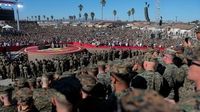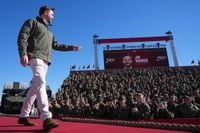On a sunny Saturday afternoon, October 18, 2025, what was meant to be a celebration of military heritage at Camp Pendleton turned into a moment of alarm and controversy. As the U.S. Marine Corps marked its 250th birthday with a live-fire demonstration simulating a beach assault, a 155 mm artillery round fired from an M777 Howitzer detonated prematurely over Interstate 5, sending metal shrapnel raining down onto a parked California Highway Patrol (CHP) cruiser. No one was hurt, but the incident has since sparked a flurry of questions, finger-pointing, and official investigations.
The demonstration, attended by Vice President JD Vance and Defense Secretary Pete Hegseth, was supposed to be a showcase of Marine Corps capabilities and a nod to tradition. According to CNN, the event drew an estimated 15,000 attendees, all there to witness the spectacle of artillery and aircraft in action. But as the first shell exploded midair, the mood shifted from awe to concern. The shrapnel that struck the CHP vehicle left a "small dent and scratch," as detailed in the CHP's internal report, and two fragments measuring about 1 to 2 inches were recovered from the scene.
CHP Border Division Chief Tony Coronado did not mince words. "This was an unusual and concerning situation," he stated, as reported by the Los Angeles Times. "It is highly uncommon for any live-fire or explosive training activity to occur over an active freeway. As a Marine myself, I have tremendous respect for our military partners, but my foremost responsibility is ensuring the safety of the people of California and the officers who protect them." Coronado called for a formal after-action review, emphasizing the need to strengthen communication and coordination between federal, state, and local partners for any future demonstrations or training events near public roadways.
The incident unfolded in the midst of a broader debate over safety and protocol. California Governor Gavin Newsom had already voiced his unease about the live-fire plans, describing the idea of firing artillery over a busy highway as "dangerous." In response, he ordered a 17-mile stretch of Interstate 5 closed for the duration of the demonstration. Yet, as the Los Angeles Times and CNN reported, the Marines had conducted a test run the previous day—firing more than two dozen shells over the interstate—without notifying state officials. Motorists were on the highway at the time, raising additional concerns about public safety.
After the premature explosion, the Marines immediately terminated the exercise and canceled any further firing of live ordnance over the freeway. The area was swept for debris, and the CHP filed an internal report recommending an after-action review to evaluate the planning, communication, and coordination surrounding the event. The Marine Corps, for its part, announced its own investigation into the mishap. The batch of artillery shells used during the demonstration has reportedly been frozen and will not be used again until the cause of the premature detonation is clarified, according to CNN.
Artillery experts and retired military officers weighed in on the rarity and risks of such an exercise. As reported by the Los Angeles Times, firing artillery over Interstate 5 is "really rare" for Camp Pendleton. Most large-scale artillery training typically takes place at more remote facilities like the Marine Corps Air Ground Combat Center in Twentynine Palms or the Chocolate Mountain Aerial Gunnery Range. A retired senior Marine officer noted, "It’s so canned as we would call it, or preplanned, that there’s not a lot of training value in it." The base’s own Range and Training Area Standing Operating Procedures require that any use of non-pre-established artillery firing areas be requested 30 days in advance and undergo an environmental review—a process that underscores just how unusual Saturday’s event was.
The M777 Howitzer, the artillery piece at the center of the incident, is a formidable weapon designed to loft explosive shells in an arced trajectory over friendly forces and deep into enemy territory. Each 155 mm round weighs about 95 pounds, with roughly 15 pounds accounting for the explosive charge. The shells are equipped with fuses that can be set to detonate on impact or in proximity to a target. Military officials suspect a fuse malfunction may have contributed to the premature detonation, though the investigation is ongoing.
Adding another layer to the story is the surge in U.S. production of 155 mm shells, largely driven by the war in Ukraine. According to CNN, since 2022, American factories have ramped up production to 40,000 rounds per month, with more than 3 million shells sent to Ukraine since the conflict began. A 2024 Reuters investigation found issues with some manufacturing lines, including cracked shells and changes in the type of explosive used, which could potentially raise questions about the reliability of the munitions used in the demonstration.
The political fallout from the incident was immediate. Governor Newsom criticized both the military’s decision to fire live rounds over the freeway and the federal response to his safety concerns. "You accused the Governor of overreacting when he closed a portion of the freeway to protect the public," Newsom’s office posted on X. "Without a doubt an apology is owed—not just to Californians, but all Americans." In another post, Newsom wrote, "This could have killed someone." The White House, meanwhile, remained largely silent after the mishap, and attempts by The Hill to reach Vice President Vance’s office for comment were met with no response. The Pentagon referred questions to the Marines, who maintained that the demonstration had undergone rigorous safety evaluations and that live-fire trainings occur year-round at Camp Pendleton.
Despite the lack of injuries, the incident has prompted a thorough review of safety protocols and interagency communication. The CHP’s recommendation for an after-action review has been echoed by military officials, who are now gathering data to determine how frequently—if ever—such live-fire exercises have occurred over Interstate 5 in the past. Base maps confirm that none of Camp Pendleton’s designated artillery firing areas are located west of the freeway, and the use of beach areas for such demonstrations is a marked deviation from standard procedures.
For many, the incident serves as a stark reminder of the complexities and risks involved in coordinating large-scale military demonstrations near civilian infrastructure. As Mark Cancian, a retired Marine Corps colonel and senior adviser at the Center for Strategic and International Studies, told CNN, "The idea that when a VIP shows up you do something special for them is totally normal. What is abnormal is that the shell detonated prematurely." He emphasized that while the fragments that struck the patrol car were not moving at lethal speeds, "obviously that should not have happened."
As investigations continue and officials seek to strengthen future protocols, the episode at Camp Pendleton stands as a cautionary tale about balancing spectacle, tradition, and public safety in an era when military celebrations are as much about national pride as they are about responsible stewardship.

